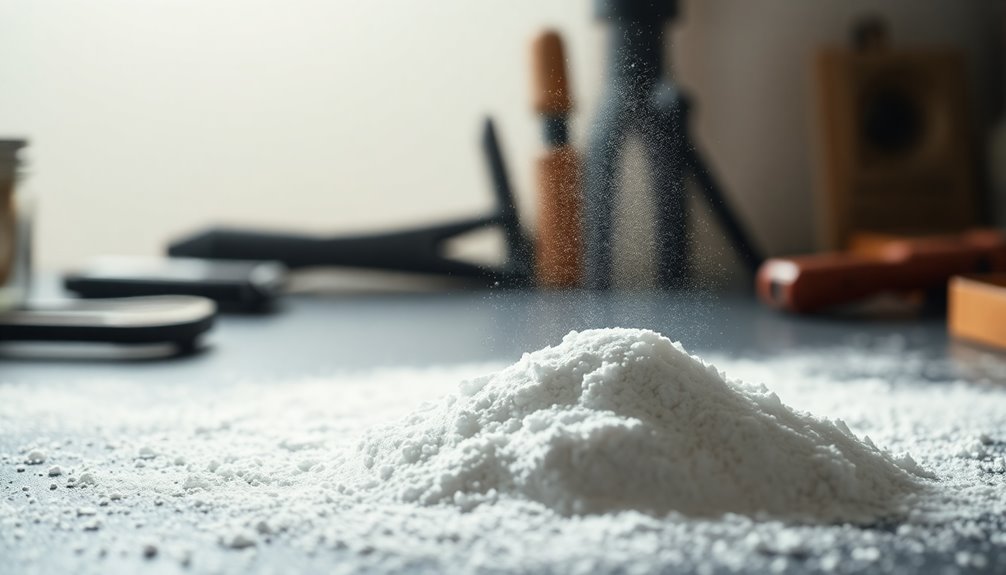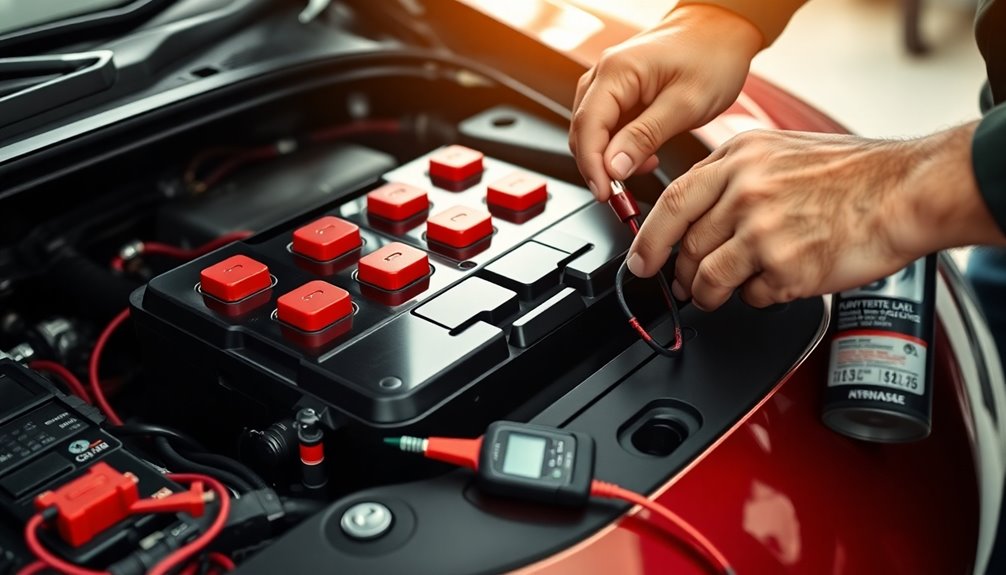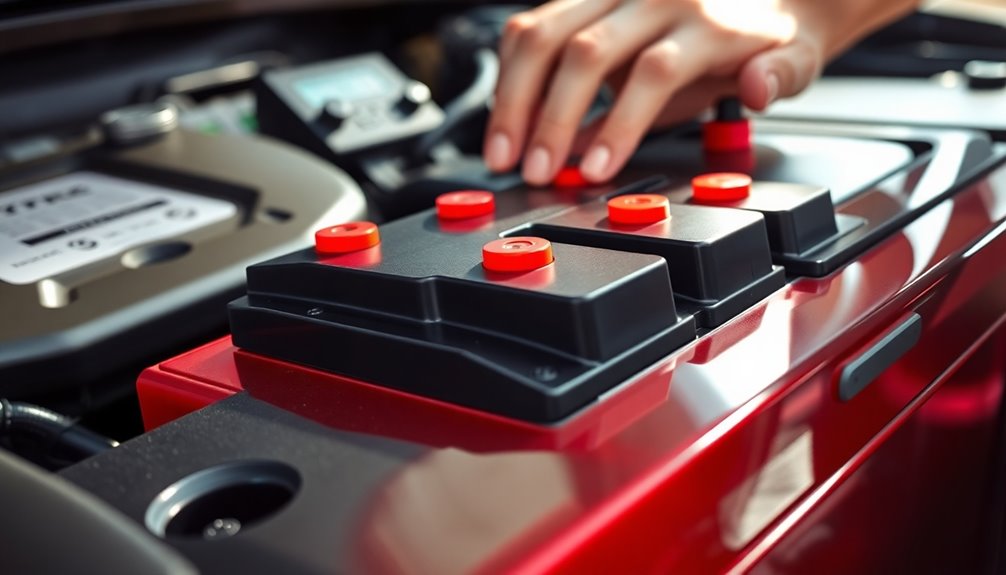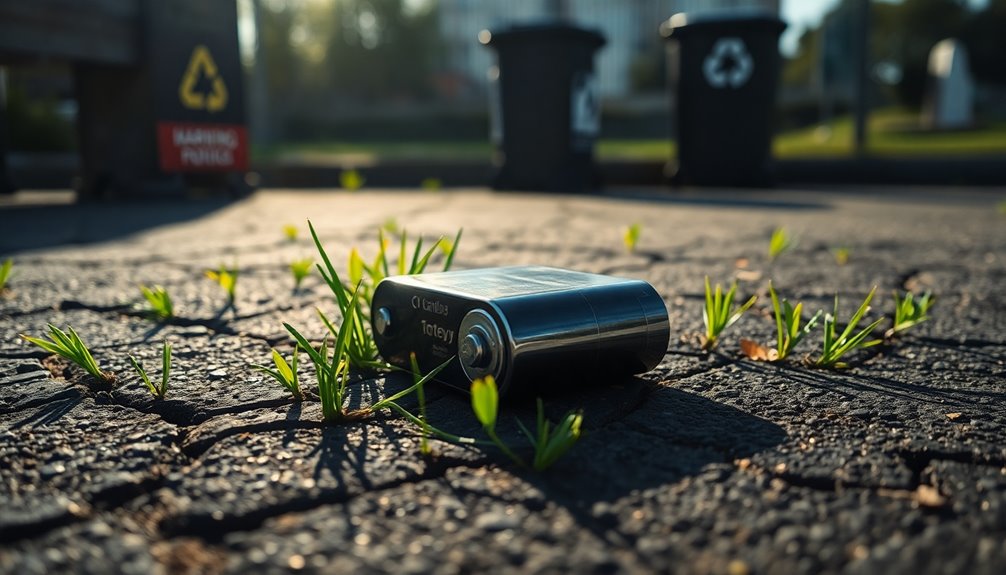Baking soda is a great temporary solution for cleaning battery terminals, but it's not a miracle fix. While it neutralizes corrosion effectively, it won't address deeper issues like sulfation or internal battery damage. You might think it's a permanent solution, but that's a myth. After applying the baking soda, you may want to use vinegar for stubborn spots, but that's not long-lasting either. Regular maintenance is key to battery health, and a thicker paste can enhance effectiveness. To truly understand the longevity of your battery, there's more you need to consider.
Key Takeaways
- Baking soda effectively neutralizes battery acid corrosion but does not permanently fix severe sulfation or internal damage in batteries.
- While baking soda can reduce visible corrosion, it does not address issues with compromised cables or terminal connections.
- Regular use of baking soda can extend battery lifespan, but it is a temporary solution and should not replace proper maintenance.
- Vinegar may assist in removing stubborn corrosion, but like baking soda, it does not provide a long-term fix for battery health.
- Misconceptions exist that baking soda can completely restore battery functionality, while it merely helps manage surface corrosion.
Baking Soda's Effectiveness
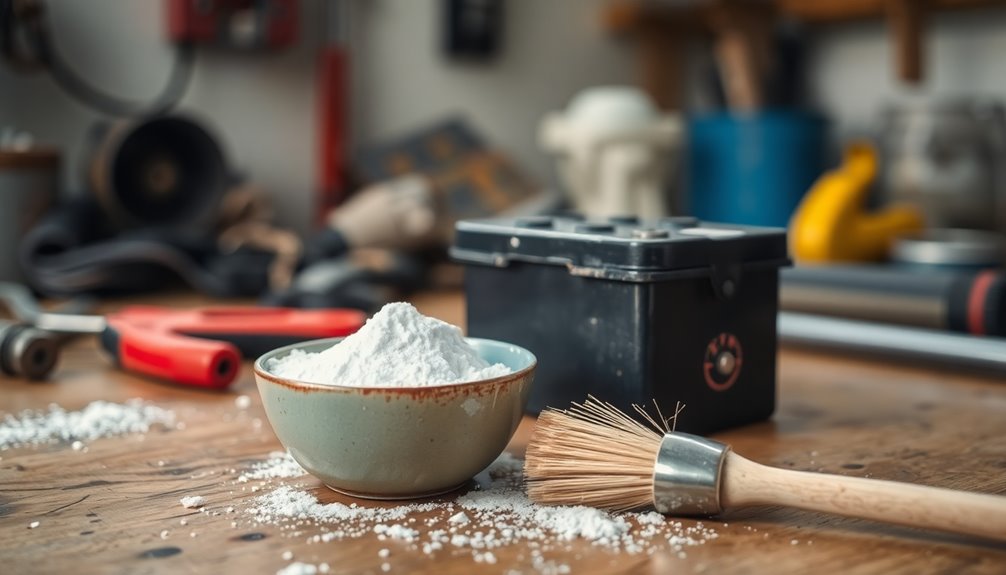
When it comes to cleaning battery terminals, baking soda proves to be a powerful ally. Its alkaline nature, stemming from sodium bicarbonate, makes it particularly effective in neutralizing battery acid corrosion.
When you mix baking soda with water, you create a mildly alkaline solution that reacts with the acidic corrosion on your battery terminals. This reaction not only neutralizes the acid but also makes the corroded areas safe to handle. Using baking soda helps scrub away corrosion effectively, preventing further damage to your battery. The chemical reaction indicates that it's working as you see the corrosion break down. Additionally, baking soda is a cost-effective, environmentally friendly solution compared to harsh chemicals, making it a great option for regular maintenance. Furthermore, regular filter replacement in other maintenance tasks can help ensure long-term health and performance.
However, while you might be eager to dive in, safety is key. Always wear protective gear like rubber gloves and eye protection, and make sure your vehicle is completely off with the battery cables disconnected before you start cleaning. Keep in mind, it's essential to avoid letting the baking soda solution seep into the battery itself. By understanding baking soda's effectiveness and taking necessary precautions, you can maintain your battery's health and extend its lifespan.
How to Prepare the Solution
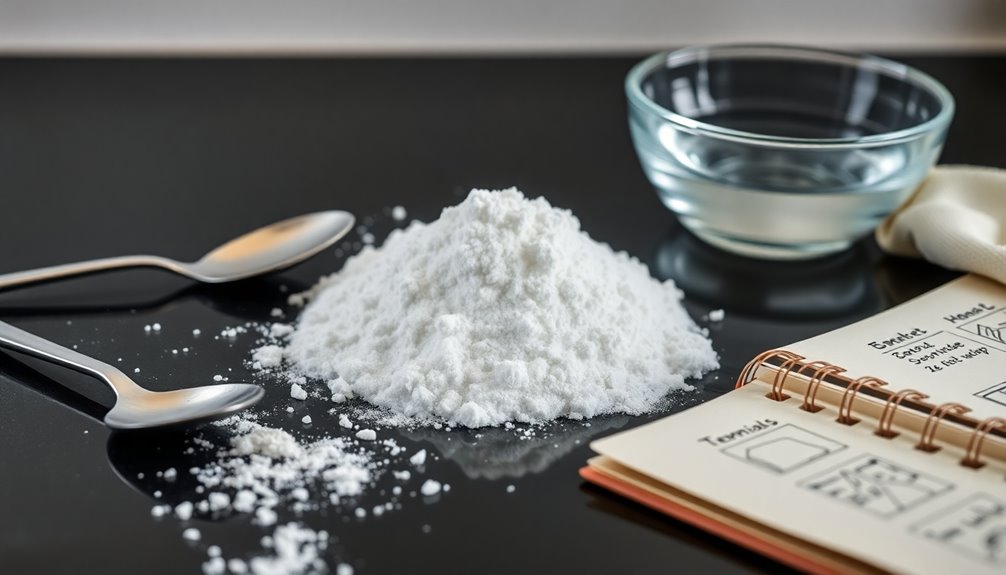
Preparing your baking soda solution is straightforward and requires just a few simple ingredients. You'll need baking soda and either distilled or warm water. For a basic mixture, use about 1 tablespoon of baking soda for every cup of water.
If you want a thicker paste, mix 4 tablespoons of baking soda with ¼ cup of water, or for a more substantial paste, try 6 tablespoons of baking soda with 4 cups of water.
To mix the solution, combine the baking soda and water in a cup until it's smooth and free of lumps. It's best to avoid mixing directly on the battery case, as this can create a mess. Using warm water helps the baking soda dissolve better. Corrosion indicates battery was recharging under high temperature or poor ventilation, so it's crucial to ensure a safe working environment.
When applying the solution, use a wire brush or an old toothbrush to scrub the terminals and cables gently. Make sure to apply the solution directly to the corroded areas, forming a paste for better adherence.
Just be careful not to let the solution get into any raised vent caps or holes. Repeat the process as needed to ensure all corrosion is removed for optimal performance.
Safety Measures to Consider
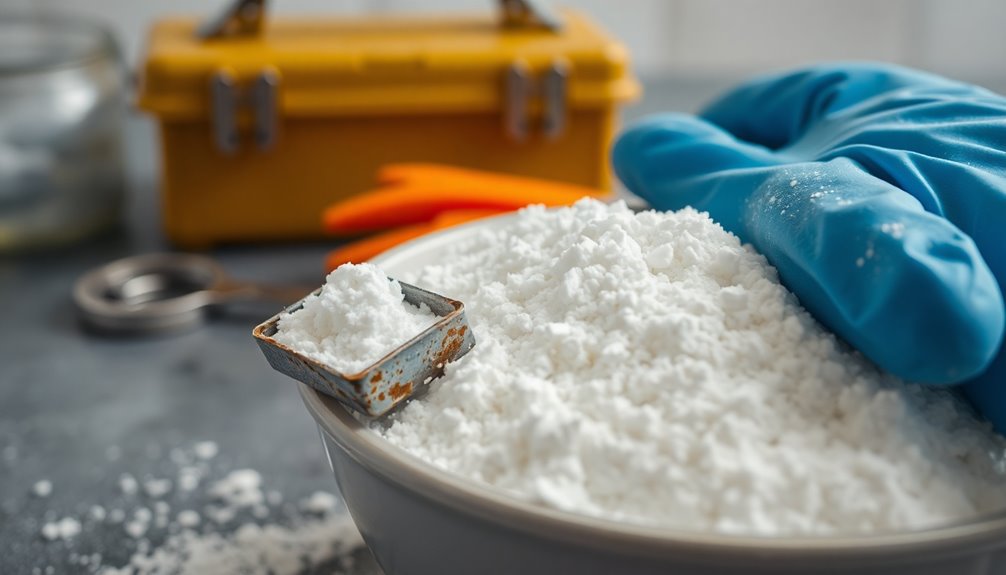
After you've mixed your baking soda solution, it's important to prioritize safety while working with batteries. First, wear protective gear. Gloves are essential to guard against acid splashes and electrical shock, so choose acid-resistant gloves.
Don't forget safety goggles to shield your eyes from any harmful substances; they should be chemical-resistant and offer full coverage.
Next, ensure your work environment is safe. Always work in a well-ventilated area to avoid inhaling battery fumes, and keep the space clear of flammable materials.
Good airflow is crucial to prevent gas buildup, so avoid cramped or enclosed spaces.
When handling the battery, disconnect the negative terminal first, followed by the positive. Reconnect them in reverse order.
Before cleaning, check the battery for any physical damage; if you find any, consider replacing it. Also, make sure no water enters the battery's vents.
Take additional precautions by preventing the baking soda solution from seeping into the battery. Use a stiff-bristle brush carefully, and consider applying anti-corrosion pads afterward.
Regularly inspect the terminals for signs of corrosion, and always keep your cleaning materials out of reach of children. Additionally, regular inspections can help catch corrosion early to ensure optimal battery performance.
Comparing Cleaning Methods
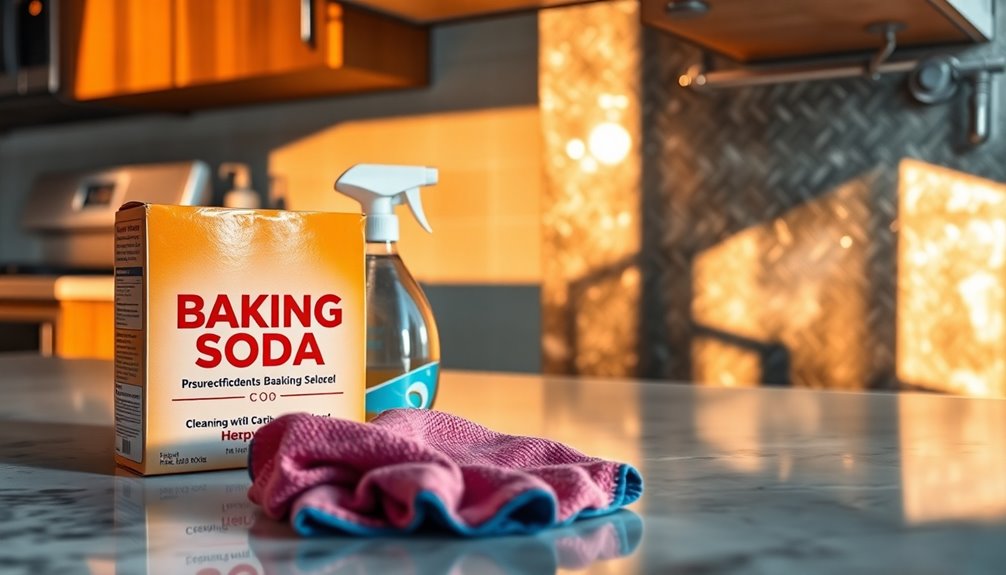
Cleaning methods vary widely in effectiveness and practicality, so it's crucial to understand your options. Traditional manual-chemical disinfection can reduce microbial burden, but results can be inconsistent. Studies show mean reductions of 38.4% to 84%, depending on the method used. While these methods are accessible and familiar to most cleaning staff, they often require thorough cleaning of all frequently touched surfaces.
On the other hand, automated and advanced disinfection methods, like focused multivector ultraviolet (FMUV) light technology, have proven much more effective, achieving a reduction of 96.5% in microbial burden. Other techniques, such as hydrogen peroxide vapor and steam cleaning, also show promise but may require specific protocols and safety measures.
When considering baking soda, it's important to note that while it excels at removing stains and grease, it leaves a residue if not rinsed properly. It works well as a scouring agent but isn't suitable for all surfaces.
Each cleaning method has its strengths and weaknesses, so evaluating your specific environment and needs is essential in choosing the right approach for effective cleaning.
Preventing Future Corrosion
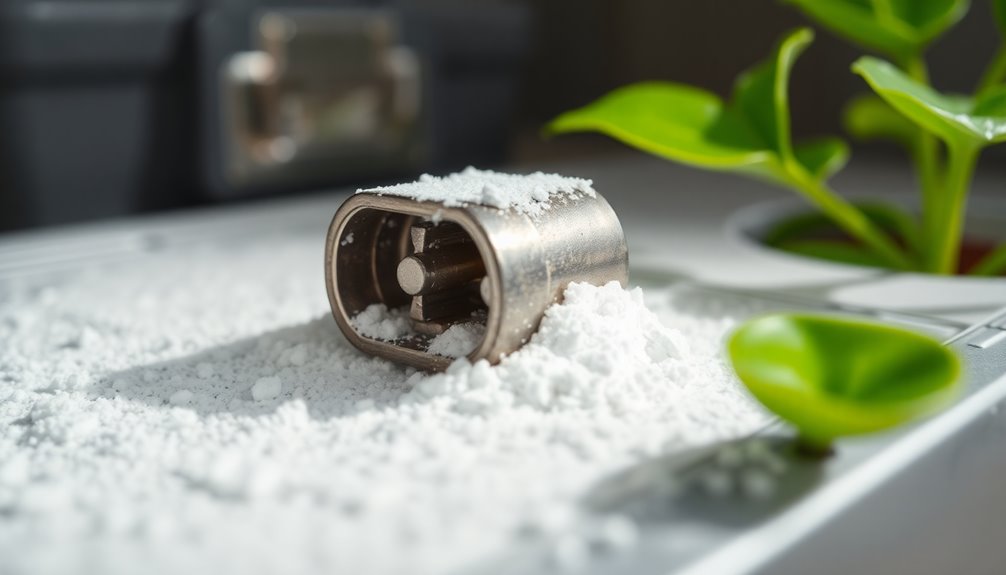
Corrosion prevention is vital for extending the lifespan of metal components, especially in environments prone to moisture and temperature variations.
Start by applying effective coatings. Zinc plating offers a sacrificial layer that corrodes before the terminal itself. Consider anodizing, which creates a protective oxide layer, or black oxide for enhanced aesthetics and corrosion resistance. If you're looking for superior protection, epoxy-based coatings, while pricier, can provide excellent durability.
Don't overlook the role of dielectric grease. This grease acts as an insulator, preventing electrical shorts and forming a barrier against corrosive elements. Apply it after cleaning your terminals with a wire brush to ensure a uniform layer. Regular checks and reapplications are crucial to maintaining its effectiveness. Additionally, poor electrical connections can lead to increased heat, accelerating the corrosion process, so ensure all connections are tight and secure.
Be mindful of temperature fluctuations, as they can increase the oxidation rate and stress the metal structure. Choose coatings that can withstand these changes, and look for self-healing options that can repair minor damage.
Finally, adopt proper maintenance practices: disconnect battery cables, clean terminals, and inspect protective measures regularly. By following these steps, you'll significantly reduce future corrosion risks and prolong the life of your equipment.
Common Myths Debunked
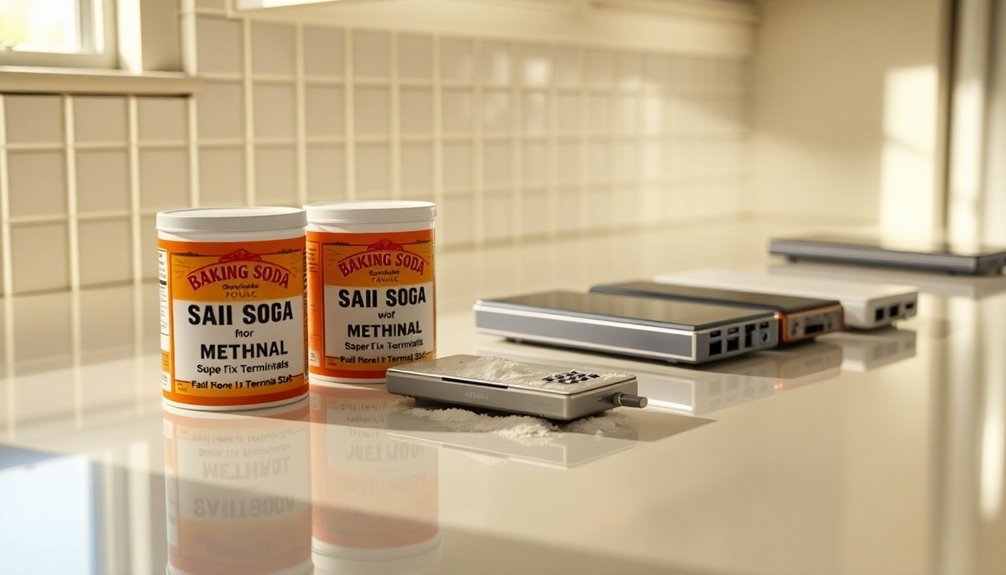
While many believe that baking soda is a miracle solution for battery terminal issues, it's important to separate fact from fiction.
Yes, baking soda can neutralize acid and clean corrosion when mixed with water to form a paste. However, this method merely addresses the symptoms, not the underlying problems. If you think baking soda will fix damaged metal or prevent future corrosion indefinitely, you're mistaken. This method is more of a temporary maintenance fix than a comprehensive repair. It's crucial to understand that if your battery has severe sulfation or internal damage, baking soda won't help. Additionally, if your cables are compromised, no amount of baking soda will restore them. Regular inspections are vital for preventing common battery issues.
After using baking soda, you should also apply vinegar to tackle any stubborn corrosion, but remember that this isn't a permanent solution.
Regular inspections and maintenance are essential to keep your battery terminals in top shape. Ultimately, while baking soda has its merits, it shouldn't be relied upon as a catch-all remedy. Proper battery care and addressing root causes are key to preventing future issues.
Misunderstanding Corrosion Causes
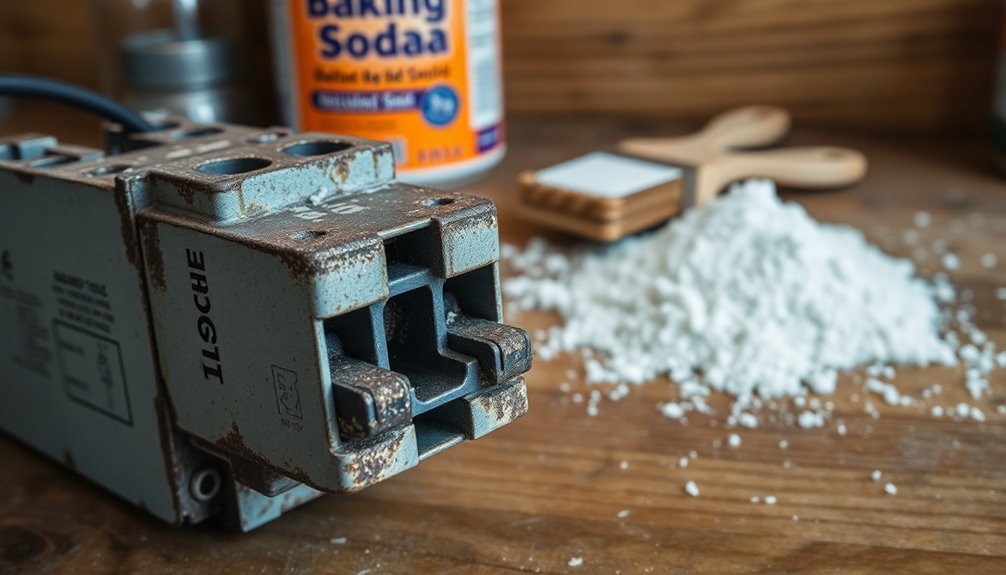
Many people overlook the real causes of corrosion on battery terminals, often attributing it solely to the use of baking soda. In reality, corrosion primarily results from a chemical reaction between battery acid and the metal terminals. When your battery is charging, it releases hydrogen gas, which accelerates this process.
Coupled with moisture, salt, and other environmental factors, this creates a perfect storm for corrosion. Living in humid areas can significantly heighten this issue. The moisture in the air, along with airborne minerals and pollutants, contributes to a corrosive environment.
If your battery is overfilled, excess fluid can escape through vents and come into contact with terminals, leading to corrosion. Overcharging the battery can cause it to heat up, releasing more electrolytes that further exacerbate the problem. Additionally, regular maintenance, including annual cleaning, can significantly reduce the risk of corrosion buildup.
You might notice corrosion appearing in various colors—white, blue, green, or brown—indicating different stages of these chemical reactions. Understanding these causes is essential for maintaining your battery's health.
Regular inspection and cleaning are crucial to prevent corrosion and ensure reliable vehicle performance.
Baking Soda's Maintenance Role
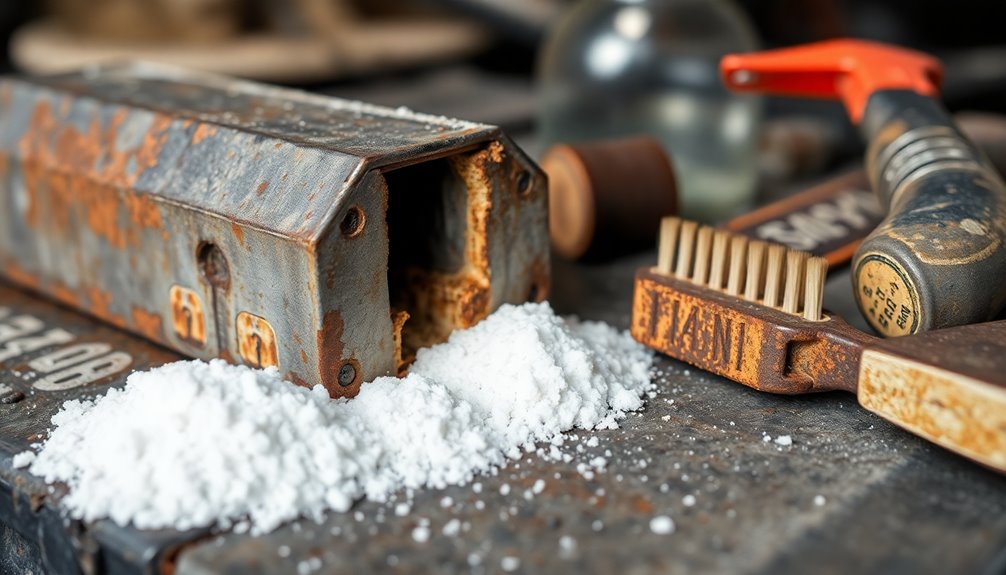
Baking soda plays a crucial role in maintaining your battery's health by effectively neutralizing corrosion. When you mix one tablespoon of baking soda with a cup of water, you create a powerful cleaning solution. This mixture reacts with the acidic corrosion often found on battery terminals, helping to neutralize and eliminate it safely.
To clean your battery terminals, first disconnect the negative and then the positive cables. Dip an old toothbrush or stiff-bristled brush into the baking soda mixture and scrub the terminals thoroughly. You'll notice bubbling, which indicates that the corrosion is being neutralized. Additionally, using protective gloves during this process will ensure your safety and prevent skin irritation.
After scrubbing, rinse the terminals and cable ends with clean water to remove any residue, then ensure everything is completely dry.
For ongoing maintenance, aim to clean your battery terminals every six months to prevent excessive buildup. After cleaning, applying a thin layer of petroleum jelly acts as a protective barrier, keeping corrosion at bay.
Regularly checking your battery for signs of leakage or swelling is also important. By following these steps, you can enhance your battery's longevity and performance effectively.
Recognizing Serious Battery Issues

Proper maintenance can help extend your battery's life, but sometimes issues arise that require immediate attention. You should be on the lookout for visual signs of battery problems.
If you notice corrosion on the terminals, characterized by a blue-green powder, or a warped and bulging battery case, it's time to act. Swelling or cracking of the battery can indicate internal damage, while any visible irregularities suggest that your battery may no longer be reliable. Regularly inspecting battery terminals for corrosion can help catch problems early.
Listen for electrical and starting issues, like a clicking sound when you try to start your engine or dim headlights. If your dashboard lights flicker or your accessories become sporadic, these symptoms can signal a failing battery.
You should also pay attention to odors. A rotten-egg smell or any hint of acid leakage is a clear indicator of a problem.
If you find yourself needing frequent jump-starts or your battery struggles to hold a charge overnight, these are strong signs of serious battery issues. Ignoring these symptoms could lead to more significant problems down the line, so don't hesitate to have your battery checked by a professional.
Frequently Asked Questions
Can Baking Soda Be Used on Other Types of Corrosion?
Yes, you can use baking soda on other types of corrosion. Its abrasive properties help scrub away rust and surface contaminants from various metals, like copper and aluminum.
Just mix it with water to form a paste, apply it to the corroded area, and scrub gently. Rinse thoroughly afterward to prevent further corrosion.
However, be cautious with softer metals, as the grit can be too harsh for some surfaces. Regular maintenance can keep your items in good shape.
How Often Should I Clean Battery Terminals With Baking Soda?
You should clean your battery terminals at least once a year, but if you live in a humid or salty area, aim for every six months.
Whenever you notice visible corrosion or starting issues, it's time to act. Using baking soda can help neutralize corrosion effectively.
After cleaning, consider applying a protective layer, like petroleum jelly, to keep those terminals clean longer and avoid future buildup.
Regular checks will keep your battery performing well.
Is Baking Soda Safe for All Battery Types?
Yes, baking soda is safe for most battery types. Its mild alkaline properties effectively neutralize acidic corrosion without harming the terminals or the battery casing.
Just mix it with water to create a paste, and scrub the affected areas gently. Always ensure you're in a well-ventilated space and wear gloves and goggles for protection.
Regular maintenance can help keep your battery terminals clean and functioning optimally, preventing further corrosion issues.
Will Baking Soda Damage Battery Components?
Baking soda won't damage battery components when used correctly. It neutralizes acid and helps clean corrosion without harming the metal.
Just make sure to avoid getting the mixture inside the battery case or vent caps. After cleaning, rinsing with fresh water is enough to remove any residue.
Can I Use Baking Soda on Car Electrical Connections?
Yes, you can use baking soda on car electrical connections. It effectively neutralizes acid buildup and removes corrosion, improving electrical flow.
To do this, mix one tablespoon of baking soda with a cup of hot water, apply it with an old toothbrush, and scrub gently. Rinse thoroughly afterward.
Just remember to wear gloves and safety goggles, and always disconnect the battery terminals before starting. Regular maintenance can enhance your vehicle's reliability.
Conclusion
In conclusion, while baking soda can help with minor terminal corrosion, it's not a miracle solution for all battery issues. Remember to prepare the solution correctly and prioritize safety when cleaning. It's also essential to understand the true causes of corrosion and recognize when a battery needs professional attention. By staying informed and using effective cleaning methods, you can prevent future problems and maintain your vehicle's performance. Don't let myths mislead you—be proactive in your battery care!

